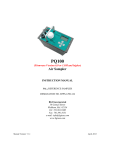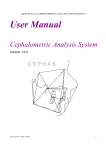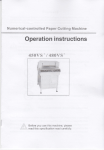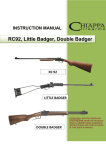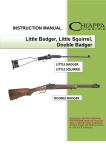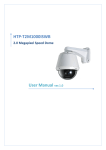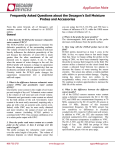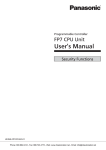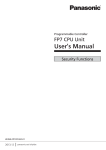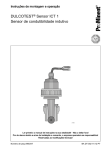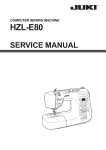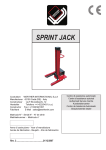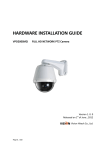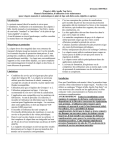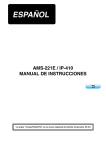Download Service Manual
Transcript
R 1-NEEDLE LOCKSTITCH SEWING MACHINE WITH AUTOMATIC THREAD TRIMMER FOR PROFESSIONAL TL-98E SERVICE MANUAL 293-27707 CONTENTS [1] SPECIFICATIONS OF TL-98E........................................................................ 1 [2] PRINCIPLE OF ELECTRIC BRAKE ............................................................... 2 [3] NAMES OF COMPONENTS ........................................................................... 3 [4] DISASSEMBLY AND ASSEMBLY ................................................................. 3 [5] PRINTED CIRCUIT BOARD DIAGRAM (CONNECTOR LAYOUT) ............. 15 [6] ADJUSTMENTS OF COMPONENTS ........................................................... 16 WARNING : To avoid the risk of fire, electric shock, injury to persons or damage to components, especially keep the following : • • • When disassembling, assembling or adjusting the sewing machine, remove the power plug. When assembling, be careful about the electrical cord being caught with other components, damage to the covered parts of the cord or miswiring. When replacing the part(s), use the genuine part(s). [1] Specifications of TL-98E (1) Speed control device Foot controller method : 80 to 1,500 rpm (2) Table and stand components Main unit : Handle : Portable type main unit with soft case (Case is folded in two and packed with main unit.) One-touch type auxiliary table knee lifter is provided as standard. (Packed together) Pull-up/down from machine main unit type (3) General mechanism 1. 2. 3. 4. Thread take-up Hook Pressing pressure adjustment Lighting device : : : : : : : : Slit type link thread take-up for one-touch threading DB type horizontal full-rotary hook Stepless adjusting screw with pressing pressure indicator method Built in face cover Switch : Slide type Lamp ...... Halogen lamp Thread guide of thread post is of tilting type and capable of one-touch threading One-touch action : Starting method by controller Automatic stop when bobbin thread winding completed ON/OFF 2-step method By lever : 7 mm Max. by lever : 10 mm By knee lifetr : 12 mm Disk pressure adjusting type with simplified disk pressure scale 2-step changeover by knob method (Feed dog : UP : DOWN) : : Dial method ......Stepless 0 to 6 mm Lever method ...... Feed amount conforms to that of normal feed stitch. 5. Needle thread post : 6. Bobbin thread winder : 7. 8. 9. 10. Power switch Lift of presser foot Thread tension Drop feed (4) Feed mechanism 1. Feed amount adjustment 2. Reverse feed stitch (5) Special mechanism 1. Automatic thread trimming 2. 3. 4. 5. : Thread trimming switch is used in common for pushbutton type and for external foot pedal switch type. Needle bar stop position : Electric brake stop method Stop by controller : Down stop Stop by automatic thread trimming : Up stop Stop by bobbin winder : Up stop Needle up/down switch : Switch is of pushbutton type and up/down stop by half rotation of main shaft Prevention of reverse setting of needle : Needle is attachable to normal direction only. Motor protection Overcurrent : When motor is locked for approximately one second due to sudden overload, motor power is automatically turned OFF and returns to the ON state immediately. Overheat : When motor temperature has abnormally risen, motor power is turned OFF (thermal cut) and returns to the ON state when temperature has fallen. (6) Dimensions and weight Main unit : 452W x 219L x 319H (mm) Weight : 11.3kg (7) Power consumption Whole sewing machine Lamp : 120V 1.4A/60Hz : 12V 3W (Halogen lamp) –1– [2] Principle of Electric Brake Three lead wires are drawn out from the motor. Lead wire is drwan out from the connecting point of the rotor coil and stator coil to use the electric brake. MP detection printed circuit board asm. detects the number of slits of the shield plate fixed on the motor shaft and is used to calculate the number of rotations of the motor and the phase of main shaft. There are 72 pcs. of slits on the shield plate per circle. If the slit is converted into the main shaft angle, the position can be measured (calculated) in a unit of 0.4 degrees. Comparing with the conventinal model, the number of slits are increased and unevenness of rotation can be controllable. Principle of the electric brake is called dynamic braking. The rotor becomes the dynamo and generates the electric power while motor is rotating. Electric brake makes use of the fact that the brake is applied to the motor by consuming this electric power. The higher the number of rotations becomes, the more the brake force becomes and the lower the less. At the time of normal rotation of motor Brake : Off At the time of motor brake Brake : ON Motor drive : ON/OFF Motor drive : Full wave phase control At the time of inertia stop or normal stop of motor Brake : OFF Motor drive : Oscillation Motor drive : OFF Motor drive : Oscillation Motor drive : OFF : Motor drive ON Motor drive simplified diagram –2– [3] Names of Components Thread guide base Presser spring regulator Arm cover asm. Thread guide No. 1 Indicating needle of presser spring regulator Face cover Bobbin winder shaft Belt cover Handwheel Stitch dial Pressure indicating plate Thread take-up thread guide Needle up/down switch Automatic thread trimming switch Lamp switch Thread take-up spring Reverse feed stitch lever Presser bar connection thread guide Drop-feed knob Lamp bulb Hand lifter lever Needle bar thread guide (Hole for auxiliary table support plate) Bed cover Needle bar thread bracket (Hole for auxiliary table support plate) Bed cover rubber seat Side cover Throat plate asm. Hole for knee lifter lever setting Thread take-up spring adjusting plate Standard presser foot asm. [4] Disassembly/assembly Page Outer Components 1. Arm cover asm. ...................................... 4 2. Belt cover and motor cover .................... 4 3. Face plate asm. ...................................... 4 4. Bed cover mas. asm. .............................. 5 5. MAIN circuit board asm. ......................... 5 Function components 1. Motor asm. and transformer asm. .......... 5 2. Handwheel and clutch ............................ 6 3. Thread tensioner asm. ........................... 6 4. Presser bar ............................................. 7 5. Needle bar .............................................. 7 6. Thread take-up ....................................... 8 7. Reverse feed stitch lever ........................ 8 8. Idler ........................................................ 8 9. Stitch dial ................................................ 9 10. Automatic thread trimming switch case .. 9 Page 11. 12. 13. 14. 15. Wire holder ............................................. 9 Knee lifter lever ..................................... 10 Hook driving shaft pulley ......................... 11 Hand lifter lever ..................................... 12 Drop-feed knob ..................................... 12 Automatic thread trimming components 1. Looper mas. asm. ................................. 13 2. Moving knife arm installing plate mas. asm. ..................... 13 3. Thread trimming solenoid mas. asm. ... 14 4. Moving knife base mas. asm. ............... 14 –3– 6 Convex of presser spring regulator knob Outer Components 1. Arm cover asm. 5 Slit of presser regulating screw 4 MAIN circuit board case cover 1 Arm cover setscrew SM5042005SN 3 Arm cover 2 Bobbin winder connector Disassembly Remove two setscrews of 1. Disconnect and remove connector of 2. Remove MAIN circuit board case cover of 4. Assembly Attach case cover of 4. Insert connector of 2. Align convex of 6 with slit of 5 and tighten the setscrew. Point ™ There should be no torsion or distorsion in presser spring regulator. ™ Align precisely slit portion with convex portion. ™ Do not press each lead wire. 2. Belt cover and motor cover 2 Motor cover setscrew SM5041255SN 1 Belt cover setscrew SM5041255SN Disassembly Remove four setscrews of 1 and remove belt cover. Remove three setscrews of 2 and remove motor cover. Assembly ™ Attach belt cover and tighten setscrews. ™ Attach motor cover and tighten setscrews. 1 Lamp connector 3. Face plate asm. Preparation ™Remove arm cover. Point ™ There should be no difference in level between belt cover and front face of frame. ™ Make motor cover come closely contact with belt cover. 5 Face cover 4 Indicating needle of presser spring regulator 3 Face plate asm. 2 Face plate asm. setscrew SL5040631SE 6 Hand lifter lever spring Disassembly Disconnect 1 connector and remove 6. Remove setscrews of 2 and remove 3 face plate asm. (together with face cover). Assembly ™ Attach face plate asm. and tighten setscrews. ™ Insert connector. –4– Point ™ There should be no difference in level around the cover when face cover is closed. ™ 5 should not come in contact with indicating needle of 4. 4. Bed cover mas. asm. 1 Bed cover setscrew 1 Bed cover setscrew SM5051255SN Disassembly Remove six setscrews of 1 and remove bed cover. Assembly ™ Attach bed cover and tighten setscrews. Point 5. MAIN circuit board asm. Preparation ™ Remove arm cover asm. Note) Setscrew to set the circuit board and cover to circuit board case Do not insert in the reverse direction. (See page 15.) Disassembly ™ Remove 10 connectors of each lead wire. Remove lead wire from mini-clamp of 1. Remove setscrews of 2 and 4, and remove circuit board. Function Components Cord guide plate asm. 1 Mini-clamp (4 places) Never loosen this screw. Porality exists. Assembly Attach circuit board and tighten setscrews. ™ Insert each lead wire into connectors. Point ™ Read the note and understand it. ™ Ther are color indications on the circuit board for inserting connectors. 3 Motor setscrew nut 1. Motor asm. and transformer asm. 1 Motor asm.setscrew SM5050855SN Preparation ™ Remove arm cover asm. ™ Remove belt cover and motor cover respectively. Make a memorandum of cord wiring. Disassembly ™ Cut clip band of 5 cord guide plate asm. in previous item. Remove two setscrews of 1 and remove motor asm. Remove two setscrews of 2 and remove transformer asm. Make sure of wiring route. 2 MAIN circuit board case setscrew A SL5030831SF 5 Cord guide plate setscrew SM5030655SN 4 MAIN circuit board case setscrew B SM5031401SE Do not loosen this screw. 3 MAIN circuit board setscrew 2 Power transformer setscrew SM5040855SN Position of cable Assembly ™ Attach transformer and tighten setscrews. ™ Attach motor asm. and tighten setscrews. ™ Attach cord guide plate asm. and tighten setscrew. –5– Point ™ Loosen nuts of 3 to adjust motor tension. ™ Belt tension : the belt should sag 3 to 4 mm when center of belt is applied with 1.96N load. 2. Handwheel and clutch !0 Groove of handwheel Preparation ™ Remove belt cover. 7 Convex of handwheel bushing 9 Motor pulley 1 Handwheel setscrew 6 Groove of handwheel bushing 4 Angle portion of clutch spring 2 Handwheel 5 Hook portion of clutch spring 3 Groove of clutch spring support 8 Handwheel bushing stopper pin Disassembly Remove setscrew of 1. Remove cord guide plate setscrew and remove cord guide plate asm. Remove spring support of 3. Move 4 in the direction where clutch spring is released and remove clutch spring. Face 6 to motor side and 8 is hard to drop. Draw out 8 and remove 9. Assembly Attach 9 and enter 8. ™ Enter groove 6 of bushing to stopper pin 8 and attach bushing. ™ Enter hook portion 5 of spring to slit in the center of handwheel bushing ™ Enter clutch spring 5 to groove 3 of spring support and attach cord guide plate asm. Then tighten setscrew. Point ™ Align convex 7 of bushing with groove !0 of handwheel and attach handwheel. Then tighten setscrew. Clearance provided between convex of clutch spring support 3 and clutch plate is 2 ± 0.5 mm. See item 12 on page 19 for adjustment. 3. Thread tensioner asm. 3 Thread take-up spring 4 Thread tensioner asm. 5 Thread tension disk presser 1 Thread take-up spring adjusting plate setscrew SL5030801SN 2 Thread tensioner setscrew SM8040602TP Disassembly Remove setscrew of 1. ™ Lower presser foot and remove setscrew of 2. Remove spring of 3 together with thread tensioner asm. of 4 and adjusting plate. Assembly ™ Attach adjusting plate and spring 3 to thread tensioner asm. and attach it to frame. Then fix it with setscrew of 2. ™ Tighten adjusting plate setscrew 1. –6– Point ™ Place upward the scale of thread tension disk presser 5. ™ See items 9 and 10 on page 18 for adjustment of pressure and stroke of thread take-up spring. 2 Presser spring regulator 4. Presser bar Preparation ™ Remove arm cover asm. ™ Remove face plate asm. ™ Remove presser foot and setscrew. 7 Indicating needle of presser spring regulator 4 Presser spring 6 Presser bar lifting lever 5 Presser bar connection asm. 8 Hand lifter lever 1 Presser bar connection setscrew SM8060502TP 3 Presser bar Disassembly Lower lever of 8 and loosen setscrew of 1. Remove regulator screw of 2. Drawing 3 upward, remove spring of 4. Remove connection of 5 and lever of 6. Do not remove indicating needle of 7. 3 is hard to remove since secrew mark is attached. 5. Needle bar Assembly ™ Set lever 6 to frame, and then set connection 5. ™ Attach spring 4 when setting presser bar 3 from upper side. ™ Attach regulator screw 2. 1 Needle bar upper bushing felt 6 Needle bar crank left screw Preparation ™ Remove arm cover asm. ™ Remove face plate mas. asm. ™ Remove presser bar. 2 Needle bar connection setscrew SM8060510SP 4 Needle clamp 5 Needle bar 3 Needle bar thread bracket setscrew A1420-001-000 Disassembly Remove 3 and 4. Remove felt of 1. Loosen setscrew of 2 . (Pushing needle bar 5 upward is acceptable.) Draw out 5 upward. Remove left screw of 6 and remove crank rod. Point ™ Set spring 4 under indicating needle 7. ™ Lower lever 8 and temporarily tighten it at the position where top end of 3 protrudes approximately 4 mm from frame. For the adjustment, see item 3 on page 17. ™ Needle should not interfere with presser foot. 7 Needle mis-insertion preventing plate Assembly ™ Attach crank rod and tighten it with 6. ™ Perform positioning of needle bar and tighten needle bar connection setscrew 2. ™ Set needle bar and attach 4, 3 and 7. –7– Point ™ Position of needle bar is the place where upper engraved line of needle bar is aligned with lower end face of needle bar bushing at the needle lower dead point. See item 2 on page 16 for the adjustment. 3 Thread take-up supporting shaft 6. Thread take-up Preparation ™ Remove arm cover asm. ™ Remove face plate mas. asm. ™ Remove presser bar. ™ Remove needle bar. 1 Thread take-up supporting shaft setscrew SM8050602TP 4 Needle bar crank 6 Thread take-up support 5 Thread take-up Disassembly Loosen setscrew of 1. Loosen two setscrews of 2. Draw out thread take-up supporting shaft 3. Remove 5 and 6 together with needle bar crank of 4. Assembly ™ Set needle bar crank to thread take-up, attach it onto main unit and tighten setscrews (2 pcs.). ™ Set 6 to 5, enter thread take-up supporting shaft 3 to 6, attach it onto frame and tighten setscrew 1. 7. Reverse feed stitch lever 2 Needle bar crank setscrew Point ™ Tighten setting portion (flat portion) of needle bar crank with screw No. 1. ™ Press shaft 3 to frame side while viewing the torque and tighten setscrew 1. 5 Feed regulator Preparation ™ Remove belt cover. (Remove motor cover. ™ Remove motor mas. asm. ) 1 Reverse feed stitch lever spring 4 Reverse feed stitch lever arm 3 Reverse feed stitch lever mas. asm. 2 Reverse feed stitch lever setscrew SM5040855SN Disassembly Remove spring of 1 from arm. Remove two setscrews of 2. Remove lever arm 4 from the slot of regulator 5 when removing 3. Assembly ™ Attach lever 3 and set with setscrews 2. ™ Hook lever spring 1 to lever arm 4. 8. Idler 2 Convex portion of idler installing plate Preparation ™ Remove belt cover. ™ Remove motor cover. ™ Remove motor mas. asm. Disassembly Remove setscrew of 1 and remove idler asm. Point ™ Set lever arm 4 to the slot of regulator 5. 1 Idler setscrew SM5040855SN Assembly ™ Assemble idler and tighten it with setscrew 1. ™ Belt tension : Belt sags 6 to 7 mm when center of the belt is applied with a 1.96N load. –8– Point ™ Belt tension can be changed only by removing belt cover. Move convex portion of 2 to the left or right. 9. Stitch dial Preparation ™ Remove arm cover asm. 4 Feed regulating screw 5 Feed regulating screw • Stopper screw • Stopper nut 2 Feed regulating pin 3 Feed regulating screw stopper asm. setscrew Disassembly Loosen two setscrews of 1 and remove the dial. Be careful since pin of 2 jumps. 3 may not be removed. (Stopper screw SM8031400TP) 1 Stitch dial setscrew SM8030402TP Assembly ™ Turn regulating screw 4 full to the right. ™ Assemble stitch dial with its scale 0 up and tighten screw 1 (2 pcs.). Point ™ There should be no play in feed regulator when operating lever. (When scale is 0.) ™ Loosen stopper nut of 5. Make stopper screw strike against regulating screw 4 and tighten nut. 10.Thread trimming switch case Preparation ™ Remove arm cover asm. ™ Remove motor cover and belt cover. ™ Remove motor mas. asm. Disassembly Remove two setscrews in 1 thread trimming switch case. ™ Remove thread trimming switch case. 1 Thread trimming switch circuit board case setscrew SL4040655SN Assembly ™ Attach the switch case to frame and tighten with setscrews 1. 3 Wire holder setscrew SM5040855SN 11.Wire holder Preparation ™ Remove outer components. (Excluding belt cover and motor cover) ™ Remove presser bar. 5 Disk pressure release connecting link 4 Thread release plate –9– Point ™ There should not be no torsion between switch and frame. 1 Nut of setscrew (opposite side 9 mm) NS6620310SP 2 Wire tube presser setscrew SM4040655SN Disassembly Remove nut of 1 (left side only). Remove setscrew of 2 and remove tube presser. Remove setscrews of 3 and remove wire holder mas. asm. When removing the wire from frame, make sure of wire route in frame. Assembly ™ Lay wire in frame. ™ Assemble wire holder mas. asm. and tighten with setscrews 3. ™ Fix 2 and 1 in the reverse side of machine bed. Point ™ Pass the wire through full reverse side of stitch dial. ™ Contact 4 and 5 with each other. ™ Tube presser and tube regarding 2 should be on the same face. See item 5 on page 23 for 1. 12.Knee lifter lever Preparation ™ Remove outer components. (Excluding belt cover and motor cover) ™ Raise presser foot. 6 Knee lifetr lever 1 Knee lifter lever shaft spring setscrew SM5030455SF 4 Knee lifter link snap pin 2 Knee lifter lever shaft 3 Claw lever actuating plate setscrew SM8040602TP 8 Knee lifter link asm (claw lever plate) 7 Claw lever shaft setscrew SM5041255SN 5 Knee lifter lever shaft stop plate setscrew SM5040855SN Disassembly Remove snap pin of 4. Remove setscrews of 5 and remove 6. Remove setscrew of 1 and take out lever spring. Lower 2 and turn it to the position where 3 can be removed. Remove 3 and actuating plate, and draw out 2. Remove claw lever shaft setscrew of 7. Remove link asm. of 8. ™ ™ ™ ™ ™ Assembly Attach 8 to frame and tighten setscrews 7. Set lever shaft 2, attach claw lever actuating plate and tighten it with 3. Attach lever spring and tighten with 1. Raise frame, attach knee lifter lever 6 and tighten it with 5. Enter snap pin 4. – 10 – Point ™ There should not be a play in the axial direction of knee lifter lever shaft 2. Note) 1 to 3 may be deleted. 13. Hook driving shaft pulley Preparation ™ Remove outer components. (Excluding stop solenoid) ™ Loosen idler. ™ Remove needle. 9 Thread trimmer cam screw No. 1 3 Hook driving shaft pulley E-ring (E-6) 6 Hook driving shaft pulley eccentric shaft bushing Slit on 4 hook driving shaft pulley eccentric shaft 1 Timing belt !0 Moving knife roller arm A !1 Thread trimmer cam 5 Hook driving shaft pulley eccentric shaft B 2 Hook driving shaft pulley eccentric shaft setscrew SM8040602TP Hexagon 2.0 mm Make 7 hook driving shaft pulley come out downward. (Illustration of hook driving shaft pulley) 6 4 5 8 E-ring groove Disassembly ™ Remove timing belt from main shaft pulley. Remove belt of 1 and loosen two setscrews of 2. Remove E-6 of 3 and turn 4 to find a place where backlash in hook driving shaft pulley is large. Press 5 and push out bushing of 6 to the right side. Draw out 5 and 6, and remove 7 following the point of 7. Do not make a flaw on E-ring groove 8 when removing E-ring 3. ™ ™ ™ ™ ™ ™ Assembly Enter hook driving shaft pulley 7. Enter eccentric shaft 5 and 6. Set E-ring 3. Remove the play in hook driving shaft with 6 and tighten setscrew 2 B. Turn shaft slit 4 to adjust backlash in pulley and tighten setscrew 2 A. Set belt 1. Adjust backlash in eccentric shaft by right rotation. – 11 – Point When setting bushing 6, do not make a flaw on the end face of bushing. When setting belt onto main shaft, refer to thread trimming timing. (Simple method) ™ Lower needle bar 1.93 mm from its upper dead point. ™ Turn hook driving shaft and orient screw No. 1 9 to this side (just front). ™Enter contact of roller arm !0 to groove of cam !1. ™ Turn hook driving shaft in the reverse direction and set belt at the position where it stops. 1 Hand lifter lever 14. Hand lifter lever 2 Hand lifter lever shaft 3 M4 screw Disassembly Enter 3 to 4 screw threads of M4 screw (arm cover setscrew) in the hole of hand lifter lever shaft on frame. Hold screw head and draw out the screw. At the same time, hand lifter lever shaft 2 is drawn out. Remove hand lifter lever 1. 15. Drop-feed knob Assembly Enter hand lifter lever shaft 2 into the hole on frame. Tap head of lever shaft to fit the shaft by force and set the shaft to hole in hand lifter lever. Point End face of lever shaft that is fit by force should not be convex from frame face. 1 3 5 2 6 44 Disassembly Set drop-feed knob 1 to “NOT FEED” and remove drop-feed adjusting arm spring 2. Remove E-ring 3 of knob shaft. Remove knob shaft setscrew 4 and draw out drop-feed knob. Assembly Pass drop-feed knob through wire installing plate 5 on frame and enter E-ring. Insert drop-feed adjusting arm asm. 6, press it to E-ring 3, remove the play and tighten it with setscrew 4. – 12 – Point It is easy to remove spring 2 when drop-feed knob 1 is set to “FEED” side. Automatic Thread Trimming Components 5 Looper mas. asm. setscrew SM5040855SN 3 Looper link asm. 1. Looper mas. asm. Preparation ™ Remove bed cover. 6 Looper 2 Looper link holding shaft 7 Bobbin case (Washer A1731090000 (Center of inner hook) E-ring E-3) Disassembly Remove E-ring of 1. Remove E-ring and washer of 2. Remove looper link asm of 3. Remove moving knife arm spring of 4. Remove setscrews of 5 and remove looper mas. asm. Assembly ™ Attach looper mas. asm. and tighten setscrews 5. ™ Hook moving knife arm spring 4. ™ Set looper link and attach E-ring, washer, etc. 2. Moving knife arm installing plate mas. asm. Preparation 3 Nut (9 mm) of wire setscrew ™ Remove bed cover. ™ Remove looper link asm. (See 3 of the previous item.) ™ Remove moving knife arm spring. (See 4 of the previous item.) 1 Moving knife link shaft A E-ring E-4 Disassembly Remove E-ring of 1. Do not remove moving knife link of 6. (Remove it together with moving knife installing plate.) Remove E-ring of 2 and remove thread trimmer solenoid link B. Remove only left-side nut of 3. Loosen setscrew of 4. (To increase operability of 5) Remove two setscrews of 5 and remove installing plate mas. asm. At this time, simultaneously remove moving knife link. ( To prevent warp of moving knife link) 4 Moving knife 1 Looper link B E-ring E-3 arm spring Point ™ Place looper 6 in the center 7 of inner hook and securely tighten 5. See item 4 on page 23 for adjustment of looper moving amount. 5 Moving knife arm installing plate mas. asm. set screw SM4050855SP 4 Knee lifter lever shaft setscrew SM5030455SF 6 Moving knife link 2 Thread trimmer solenoid link B E-ring E-4 Assembly ™ Attach moving knife arm installing plate mas. asm. Note : See the point on the right side. ™ Temporarily tighten setscrews 5. ™ Attach E-ring 1 of link shaft. ™ Attach thread trimmer solenoid link B and set with E-ring 2. ™ Attach moving knife arm spring. ™ Determine position of moving knife and securely tighten 5. Note : See the point on the right side. ™ Raise knee lifter lever shaft by hand and tighten lever spring setscrew 4. – 13 – Point ™ Set moving knife link 6 and wire setscrew. ™ Position of moving knife Remove hook and see from the reverse side of bed. (See item 1 on page 21.) ™ See item 1 on page 21 for adjustment of nut 3 of wire. 5 Moving knife roller arm 3. Thread trimmer solenoid mas. asm. Preparation ™ Remove arm cover asm. ™ Remove bed cover asm. ™ Remove thread trimmer solenoid link B. (See 2 of the previous item.) 4 Moving knife arm 2 Thread trimmer solenoid link A 3 Thread trimmer solenoid mas. asm. setscrew SM5050855SN Disassembly Loosen pin setscrew of 1. Pull solenoid link A of 2 to the right and remove it from solenoid shaft. Remove two setscrews of 3 and take thread trimmer solenoid. 1 Thread trimmer solenoid pin setscrew SM8050602TP Assembly ™ Attach thread trimmer solenoid and temporarily tighten it with setscrews 3. ™ Contact thread trimmer solenoid pin and shaft with each other. ™ Attach thread trimmer solenoid link B. (E-ring) ™ Fix thread trimmer solenoid pin in the center of shaft. (See item 2 on page 21 for the adjustment.) Point ™ Position of thread trimmer solenoid : move thread trimmer solenoid mas. asm. to the left and right so that moving knife arm 4 comes in close contact with moving knife roller arm 5 when the solenoid performs suction and securely tighten 3. Looper and thread release function should not obstruct the suction when the solenoid performs suction. 4. Moving knife base mas. asm. Preparation ™ Remove bed cover. ™ Remove throat plate asm . 3 Feed dog 2 Moving knife base mas. asm. setscrew SM4040855SP Disassembly Remove E-ring of 1 and raise frame. Remove two setscrews of 2. Bring feed dog of 3 to its highest position. ™ Raising moving knfe base by hand, lightly press moving knife link A from upper side. (Release coupling.) ™ ™ ™ ™ Assembly Attach moving knife base to frame while setting moving knife base to moving knife link A. Temporarily tighten setscrews 2. Push moving knife base in the direction of right front 45˚ and securely tighten it. Tilt frame, set moving knife link shaft A and enter E-ring 1. – 14 – 1 Moving knife link shaft A E-ring Point ™ When assembling, it is better to raise by finger moving knife link A from below. [5] PRINTED CIRCUIT BOARD DIAGRAM (CONNECTOR LAYOUT) Thread trimmer solenoid Controller socket Controller 2 2 External thread 2 trimmer socket External thread trimmer (Pedal SW) Description MP detection circuit board Thread trimmer solenoid Power input Controller socket Lamp Transformer Primary side (AC120V) Secondary side (AC12V) CN11 Thread trimmer SW circuit board 3 CN7 3 MAIN circuit board CN5 CN1 5.6.7 3 CN6 Bobbin winder SW 3 MP detection circuit board MAIN circuit board Terminal Pin CN6 1 2 3 CN1 3 4 CN2 1 2 CN8 1 2 CN4 1 2 CN1 1 2 CN3 1 2 Cord color Red Brown Black Gray Orange Yellow Blue Yellow White White CN1 1.2 2 Power transformer (AC12V) 2 CN2 Power SW 2 AC120V Plug socket Main motor Description MAIN circuit board Terminal Pin CN7 1 2 3 CN5 1 2 3 CN1 5 6 7 Thread trimmer SW circuit board Bobbin winder SW Motor Blue White Yellow Yellow Lamp SW 2 CN4 CN3 CN1 3.4 CN8 Lamp Description Pedal SW Thread trimmer SW circuit board Terminal Pin CN11 1 2 Cord color Orange Black Brown Gray Black Purple Gray Red Black Cord color Brown Black (Caution) 1. CN Nos. in frame of MAIN circuit board denote connector Nos. in MAIN circuit board. 2. Portions enclosed with thick frame denote circuit boards. 3. Numerals outside of frame of MAIN circuit board denote number of lead wires. CN1 CN2 CN4 CN3 CN5 CN6 CN7 Note : Convex portion of connectors, CN1, CN2 and CN3 should be placed up. Convex portion Connector insertion diagram – 15 – CN8 [6] ADJUSTMENT OF COMPONENTS Automatic thread trimmer mechanism General mechanism 1. 2. 3. 4. 5. 6. 7. 8. 9. 10. Height of neddle bar bushing ........................... 16 Height of needle bar......................................... 16 Height of presser foot....................................... 17 Height of feed dog ............................................ 17 Feed timing ...................................................... 17 Needle-to-hook timing ...................................... 17 Clearance between needle and hook .............. 18 Position of bobbin case positioning finger ........ 18 Tension of thread take-up spring ..................... 18 Stroke of thread take-up spring (absorbing amount of thread) ........................... 18 11. Bobbin thread tension ...................................... 19 12. Position of bobbin winder clutch ...................... 19 13. Adjustment of bobbin winder ............................ 20 1. Positioning of moving knife arm installing plate (adjustment of position of moving knife) .......... 21 2. Installing position of thread trimmer solenoid (moving amount of thread trimmer cam contactor shaft) ................................................ 21 3. Thread trimmer cam timing (needle-to-cam position) .................................. 22 4. Position and protruding amount of looper (left/right position and adjustment of movement) ......................................................................... 23 5. Position of nut of wire setscrew (adjustment of thread tension disk open/close) ......................................................................... 23 General Mechanism 1. Height of needle bar bushing ™ Set dimension from top surface of throat plate to lower end face of needle bar bushing to 64.8 ±0.1mm. (bushing : driving fit) Lower end face of needle bar bushing 64.8±0.1 mm Top surface of throat plate 3 2. Height of needle bar ™ Lower dead point of needle bar ™ Align upper engraved line A on needle bar 2 with lower end face of needle bar bushing 3. ™ Perform adjustment with needle bar connection setscrew. A 3 Needle bar connection setscrew – 16 – 3. Height of presser foot ™ Adjust the height in the state that hand lifter lever is raised. ™ Clearance provided between top surface of throat plate and lower face of presser foot is 7.0±0.5 mm. Presser foot ™ Perform adjustment with presser bar connection setscrew. 7.0±0.5 mm Throat plate 4. Height of feed dog ™ Set stitch dial to 2 and bring feed dog to its highest position. ™ See the height at top end of this side of feed dog. ™ Bottom of tooth of feed dog should be aligned with top surface of throat plate. Top surface of throat plate 1.2±0.1 mm (Figure on the right side : protruding amount from top surface of throat plate is 1.2±0.1 mm.) ™ Perform adjustment with vertical feed shaft arm 1. 2 Shaft arm setscrew 1 Vertical feed shaft arm 5. Feed timing ™ Set stitch dial to the maximum. ™ Lower feed dog in the normal feed operation and align it with top surface of throat plate. ™ At this time, clearance provided between needle top and top surface of throat plate is 0±0.2 mm. ™ Perform adjustment with feed cam setscrew. Needle (HA x 1 #14) Feed cam setscrew Top surface of throat plate 0±0.2 mm 6. Needle-to-hook timing ™ Loosen three setscrews in hook. ™ Align lower engraved line 1 on needle bar with bottom end face of needle bar bushing when needle bar goes up from its lower dead point. ™ Align blade point of hook with center line of needle, check clearance between needle and hook, and tighten setscrews. 1 Remove bobbin case positioning finger to improve the work. 1 Hook – 17 – 7. Clearance between needle and hook Needle (HA x 1 #14) ™ Loosen three setscrews in hook. ™ Align blade point of hook with center of needle. Blade point ™ Adjust clearance provided between blade point of hook and needle to 0.05 to 0.1 mm. ™ Temporarily tighten setscrews, check the timing, and securely tighten setscrews. 0.05 to 0.1 mm 8. Position of bobbin case positioning finger ™ Loosen bobbin case positioning finger setscrew 1. ™ Align right end of convex of bobbin case positioning finger spring with right end of needle. Bobbin case positioning finger spring Top view ™ Temporarily tighten setscrews, hold a clearance of 0.6 to 0.8 mm between inner hook and bobbin case positioning finger, and securely tighten setscrew 2. Needle 0.6 to 0.8 mm 2 Bobbin case positioning finger should not come in Bobbin case contact with hook. Front view positioning finger 9. Tension of thread take-up spring Needle ™ Pass needle thread up to thread tensioner thread guide 1. ™ Lower presser foot and draw needle thread. Align right end of convex of bobbin case positioning finger spring with right end of needle. 1 Bobbin case positioning finger setscrew. ™ Adjust tension of thread take-up spring to 0.127 to 0.157N when thread take-up spring starts lowering. ™ For adjustment, loosen thread tensioner setscrew and turn thread tensioner 3. ™ Turning clockwise = increasing tension of thread take-up spring 4. 4 Thread take-up spring Needle thread 2 Thread tensioner 3 Thread tensioner setscrew asm. 1 Thread tensioner thread guide 10. Momentum of thread take-up spring (absorbing amount of thread) ™ Pass needle thread up to thread take-up and lower presser foot. ™ Draw needle thread from start of motion of thread take-up spring to end of its motion. ™ Needle thread is absorbed when it is returned. 10.5±0.5 mm Absorbing amount : 10.5±0.5 mm ™ Perform adjustment with thread take-up spring adjusting plate 1. – 18 – Setscrew 1 Thread take-up spring adjusting plate. 11. Adjustment of bobbin thread tension How to adjust Adjust with adjusting screw so that bobbin thread tension when spun thread #60 is used becomes 0.176±0.02N. Bobbin case Adjusting screw Bobbin thread 12. Position of bobbin winder clutch ™ Remove belt cover. How to adjust 1. Bobbin winder OFF state Turn thread trimmer clutch plate link collar 3 and adjust so that a clearance of 2±0.5 mm is provided between bobbin winder clutch plate 1 and clutch plate spring support 2, and temporarily tighten setscrew 4. 2. Bobbin winder ON state Make sure that bobbin winder clutch plate comes in contact with inner ring of clutch plate spring support and securely tighten thread trimmer clutch plate link collar setscrew. Bobbin winder OFF Bobbin winder ON 4 Link collar setscrew Bobbin winder shaft base adjusting plate 1 Bobbin winder clutch plate 2±0.5 mm 3 Thread trimmer clutch plate link collar 2 Clutch plate spring support – 19 – To come in contact with each other 13. Adjustment of bobbin winder [Position of disengaging bobbin winder] How to adjust 1. Set bobbin presser 1 to the position where it is 16 mm away from bobbin winding shaft 2. 2. Tighten bobbin winder controller asm. with setscrew when concave portion of bobbin winding shaft base adjusting plate 3 is engaged with convex portion of bobbin winder controller asm. 4. 4 Bobbin winder controller asm. 2 Bobbin winding shaft Setscrew 16 mm 1 Bobbin presser To engage with each other To strike 3 Bobbin winding shaft base adjusting plate [Position of leaf switch] How to adjust 1. Adjust so that a clearance of 0.9 mm or more should be provided between leaf switch 5 and bobbin winding shaft base adjusting plate 3 when bobbin winding shaft is ON and so that leaf switch is securely turned ON when bobbin winding shaft is OFF. Then tighten leaf switch setscrew. Bobbin winding shaft ON (leaf SW OFF) Leaf SW 5 Bobbin winding shaft OFF (leaf SW ON) 0.9 mm or more Leaf SW setscrew Bobbin winding shaft base adjusting plate 5 [Adjustment of amount of bobbin thread wound round bobbin] How to adjust 1. Tighten bobbin winder switch contactor plate 6 with setscrew at the position where bobbin winder switch 7 is turned OFF when amount of bobbin thread wound round bobbin becomes 18 mm in diameter. Bobbin winder SW contactor setscrew Bobbin winder SW 7 Bobbin winder SW contactor plate 6 – 20 – Automatic Thread Trimmer Mechanism 1. Positioning of moving knife arm installing plate (Adjustment of position of moving knife) Nut of setscrew 1 2 Knee lifetr lever shaft setscrew ™ Loosen nut 1 of setscrew ™ Loosen setscrew 2 of knee lifter lever shaft. ™ Loosen setscrews 3 in installing plate and move installing plate to the right or left to obtain position A. ™ Tighten setscrews 3 in installing plate. Reference (substitution) Position of moving knife (see from under side of bed.) Overlapping amount of slot 4 of moving knife base with portion R of moving knife is 0 to 0.5 mm. (To such an extent that portion R of moving knife is slightly seen from slot 4) 3 Moving knife arm installing plate setscrew 4 Moving knife base 2. Installing position of thread trimmer solenoid (Moving amount of thread trimmer cam contactor shaft) ™ Loosen nut 1 of setscrew. ™ Enter thread trimmer contactor shaft caulked in moving knife roller arm 2 to groove in thread trimmer cam 3. (Press it strongly by finger and trun handwheel.) ™ Move thread trimmer solenoid 5 and adjust so that moving knife roller arm 2 comes in close contact with moving knife arm 4 when thread trimmer solenoid is ON. Nut of 1 setscrew 3 Thread trimmer cam Remove E-ring of looper link B to release connection. 4 Moving knife arm 2 Moving knife roller arm 6 Thread trimmer solenoid setscrew – 21 – Attach thread trimmer solenoid pin to center of shaft. 5 Thread trimmer solenoid E-ring of looper link B 3. Thread trimmer cam timing (Needle-to-cam position) 1. Loosen two setscrews in thread trimmer cam. 2. Raise machine and lower needle bar by 1.93 mm from its upper dead point. 3. Tilt machine horizontally and face setscrew No. 1 1 of thread trimmer cam to front. (Setscrew No. 1 ..... Screw that comes first when turning handwheel in normal direction.) 4. Enter thread trimmer cam contact shaft 2 to groove in thread trimmer cam. 5. Slightly prees thread trimmer cam to handwheel side, turn it in right direction as viewed from face plate side, and tighten setscrew No. 1 at the position where thread trimmer cam 3 comes in contact with thread trimmer roller with a click. 6. Securely tighten thread trimmer cam setscrews in the order of setscrew No. 2 and No. 1. Needle (HA x #14) 1.93 mm from upper dead point 52.57 mm (13.77 mm) Throat plate (Upper stop angle 37˚) Moving knife roller arm shaft asm. Tighten setscrew when thread trimmer cam contact shaft comes in contact with this position. 1 Setscrew No. 1 2 Thread trimmer cam contact shaft 3 Thread trimmer cam – 22 – 4. Position and protruding amount of looper (Left/right position and moving amount) 4-1. Adjustment of left/right position of looper ™ Adjust with looper installing plate 2 so that center of inner hook is aligned with center of lopper 1. 2 Looper installing plate 1 Looper and inner hook 3 Looper (Convex that looper cam pushes out) 4 Looper cam (Position where it comes in contact with looper) 4-2. Adjustment of moving amount of looper ™ When thread trimmer solenoid is ON, top end of looper comes in contact with bobbin case. ™ Perform with setscrews 5 adjustment to provide a clearance of 1±0.2 mm between convex of looper 3 and looper cam 4. 5 Looper link setscrew 5. Position of nut of wire setscrew (Adjustment of thread tension disk open/close) ™ Lower presser foot. ™ When thread trimmer solenoid is ON, disk 1 should be open. (Lifting amount is 1 mm when scale is set to 3.) ™ Perform adjustment with nut on the left side after loosening nut 2 on the right side. ™ Perform fixing with nut located inside. Nut of 2 setscrew (Wrench 9 mm) Thread tension disk – 23 – R INTERNATIONAL SALES DIVISION 8-2-1. KOKURYO-CHO. CHOFU-SHI. TOKYO 182-8655. JAPAN PHONE : 03(3480)5034 FAX : 03(3480)5037 Copyright C 1998 JUKI CORPORATION. All rights reserved throughout the world. 98 · 09 Printed in Japan (E)



























